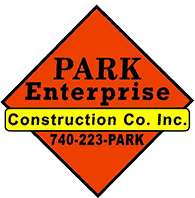If you read our blog about whether or not you need a concrete dumpster pad in your parking lot, you may have been left with this question. The simple answer is “because asphalt is weak for dumpster activity.”
As an owner or manager of a commercial property, you probably have a lot of traffic around your dumpster as garbage trucks load and unload several trash bins each week.
You may notice that the asphalt in front of the concrete dumpster pad may be cracked, wrinkled, bent or appearing to have dimples -- even if you followed the trusty asphalt paving checklist. If you are wondering what causes this, just take the time to observe as the loading and unloading of dumpsters takes place.

Reasons For the Pesky Cracks in Front of a Concrete Dumpster Pad:
The area around and below your dumpster experiences extremely heavy force from dumpsters and garbage trucks. If you observe or listen as trucks lift, empty and slam metallic dumpsters back on to the ground, you will comprehend just how much force is exerted on the surface around the trash area.
Concrete dumpster pads are sturdy enough to withstand this force, but the asphalt in front of the pads isn’t.
The Culprit:
An average garbage truck weights over 70,000 lbs. With all this weight, the garbage truck exerts a lot of downward pressure and stress to the front axle when loading and unloading dumpsters. This pressure stresses the asphalt pavement and causes it to cave in because it isn’t strong enough.
Cracked and dented asphalt is not only a recipe for pot holes creeping into your compound (which can be a pain to fix), but also an eyesore to guests visiting your property.
It can make your customers lose confidence in your business and property because of a lack of professional appearance. It will also cost you more in the long run if you keep repairing the same place with asphalt.
So, how can you avoid asphalt cracking in front of the concrete pad?
The solution is to install concrete dumpster pads that extend the whole length of a trash truck -- not just in front of the dumpster. A typical dumpster concrete pad should reach between 10 and 15 feet outside the dumpster.
This length is long enough to enable all the weight of heavy trash trucks to be contained, rather than exerting all their pressure on nearby asphalt pavement. It is intentionally designed to be that long to allow for the front wheels of the truck to be resting on the pad during dumpster loading and unloading.
How can you install concrete dumpster pads?
Consult a professional construction company to help you reinforce the area with a dumpster pad that is up-to-standard. Dumpster pads are made of concrete reinforced with a wire mesh or rebar. This combination of concrete and steel creates an incredibly strong pad that can withstand excessive force from heavy dumpsters and trucks, and for a longer time than any other surfaces.
Concrete dumpster pads also offer another significant benefit; they are not adversely affected by leakage oils or hydraulic fluids that are often excreted by trash trucks. Trash trucks leak these fluids when tremendous pressure is applied on their internal hydraulic system.
Consult Park Enterprise Construction Co. today for a sturdy and durable concrete dumpster pad built with integrity!




